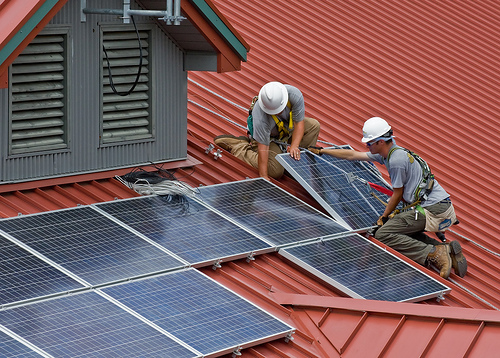Podcast: Play in new window | Download
Subscribe: RSS
 India and Australia are embracing distributed — which is to say personal, rooftop — solar power as a major source of electricity that is both renewable and much closer to sustainable than wind or solar “farms.” [See Solar “Farms” Keep us in the Dark] The United States, meanwhile, continues to focus on massive projects stitched onto the aging grid, causing massive problems for the environment and for grid management.
India and Australia are embracing distributed — which is to say personal, rooftop — solar power as a major source of electricity that is both renewable and much closer to sustainable than wind or solar “farms.” [See Solar “Farms” Keep us in the Dark] The United States, meanwhile, continues to focus on massive projects stitched onto the aging grid, causing massive problems for the environment and for grid management.
The current experience of the state of South Australia confirms most dramatically the arguments often made here and in my book Brace for Impact, that sustainability in energy production can be achieved only when people make their own power where they use it. As of last June, one in five households in South Australia had deployed rooftop solar. According to the Australian Energy Market Operator, the panels were generating 267 megawatts, or 2.4 per cent of overall demand.
Before lips curl and shouts of “insignificant” are heard, consider: the most expensive part of industrial, centralized power production is providing capacity for peak demand. It requires equipment that might be used only a few hours a day, a few months of the year, but must be ready at all times. Electricity travels at the speed of light, and on the grid any demand must be answered immediately to avoid imbalance, surges and shutdowns.
In South Australia, the aforementioned rooftop solar pittance has reduced peak demand, in a mid-summer (December and January, in Australia) that is setting records for high temperatures and air conditioning demands. And not by any two per cent. The hotter the sun shines, the more solar electricity is generated, and just when the grid needed relief most, the rooftop arrays dropped demand by as much as 15 per cent, when an increase of at least ten per cent was expected.
As a direct result, the only two coal-fired power stations in South Australia have been shut down, and additional generators capable of delivering 150 megawatts of peak power have not been needed.
India, too, is embracing rooftop solar, having just recently demonstrated what happens when you follow the course still prevalent in the United States — a massive blackout. (See India Blackout Foreshadows US Event and In a Village in India, It’s Power to the People) Last week, P S Deodhar, formerly chairman of the Electronics Commission of the Government of India, offered his country a common-sense discussion of electricity beginning with the question: “Sunlight is omnipresent. Why, then, centralise such well-distributed energy into a multi-megawatt solar farm, and redistribute it, losing 25 per cent in transmission?” Among the advantages of distributed, as opposed to centralized industrial, power generation he cited:
- small photovoltaic arrays are cheap, can be deployed quickly, and have such a small footprint that there are no land-use or ecosystem issues.
- there are no — repeat, no — transmission losses when you use the power where it is produced.
Rooftop solar is also a success story in California, where thanks to encouragement from the state government the industry has created 43,000 jobs, has drawn $10 billion in private investment and now contributed more than 1,000 megawatts to the California grid. As a result, major power companies are mounting a major campaign of disinformation [“Utilities quietly gearing up to fight solar energy,” Capitol Weekly 02/01/13] to quell enthusiasm for a trend they see as a threat to their profits.
See also: BP Dumps Solar Panel Business, and Lights Out All Over the World
Tom, You’ll have to come and see out solar PV system sometime. The Enphase microinverters are a DIY breakthrough.